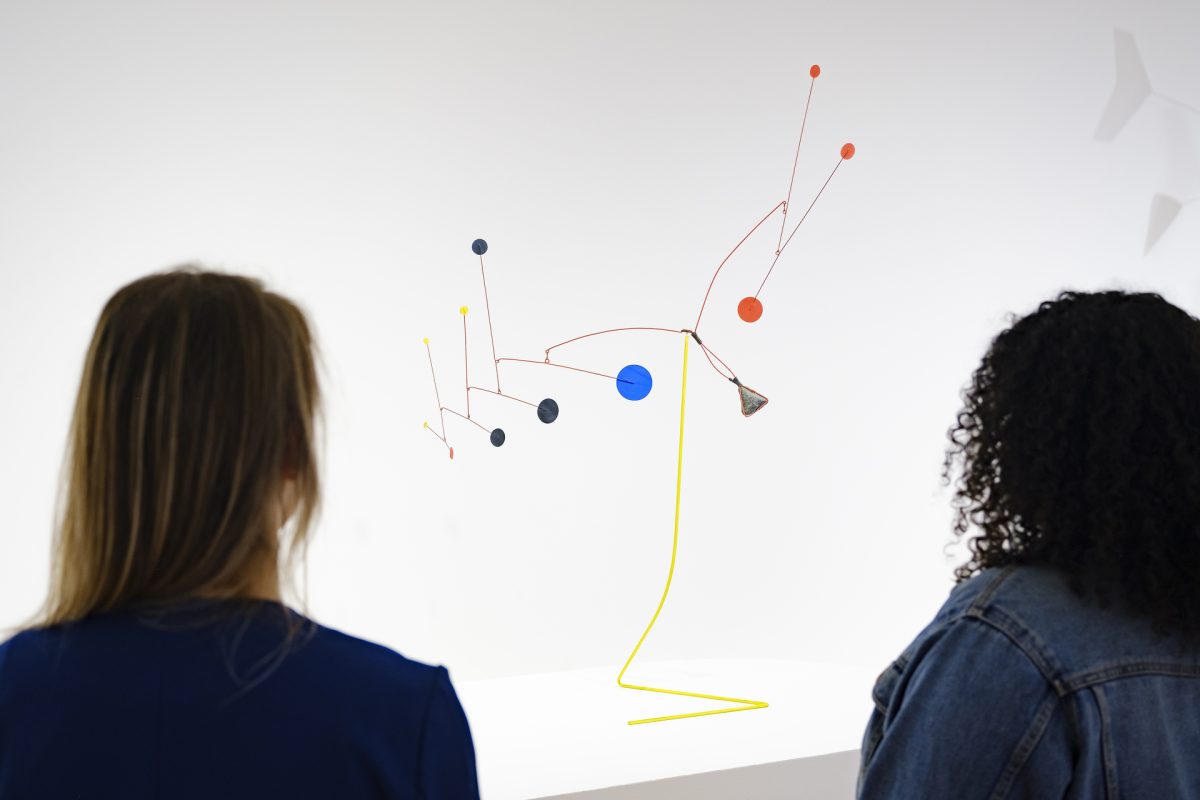Calder Smartphone Tour: Yellow Stalk With Stone

“Since the beginning of my work in abstract art, and even though it was not obvious at that time, I felt that there was no better model for me to work from than the Universe. Spheres of different sizes, densities, colors and volumes, floating in space, surrounded by vivid clouds and tides, currents of air, viscosities and fragrances—in their utmost variety and disparity.”
– Alexander Calder
Yellow Stalk with Stone is a prime example of Calder’s experimental approach to sculpture, embracing both the transcendent and the ordinary. During the artist’s lifetime, the artwork was exhibited globally with notable stops at the Museum of Modern Art in New York, the Museu de Arte Moderna in Brazil, and the Museo de Bellas Artes in Venezuela.
Despite its global adventures, the standing mobile highlights the important role of found objects in Calder’s oeuvre. Its titular stone—found by the artist on a walking meditation around his property in Roxbury, Connecticut—invites a dialogue between found, manipulated, and artificial materials in art.
Calder: In Motion, The Shirley Family Collection closes Sunday, August 4 at SAM! Don’t miss your chance to see over 45 of the iconic American artist’s renowned works (including Yellow Stalk with Stone) and explore the exhibition’s free smartphone tour from the museum’s galleries. Plus, you can listen to all 16 stops of the tour on your own time via our SoundCloud.
Yellow Stalk with Stone, 1953
NARRATOR: Calder was a truly international artist. During his lifetime, this work was exhibited multiple times, including in Brazil, New York, and Venezuela. But the stone referred to in the title came from close to home; he picked it up near his studio in Roxbury, Connecticut.
The stone creates a dialogue with the man-made elements of the sculpture. Sandy Rower:
ALEXANDER S. C. ROWER: Calder’s process of creation and composition was very intuitive. It was in the moment. It was in the spirit of the moment. It wasn’t something that was planned. He didn’t make diagrammatic plans for creating his sculptures.
NARRATOR: It’s a way of working that resonates with artist Kennedy Yanko.
KENNEDY YANKO: He’s clearly thinking in a way where he needs to explore something, where he needs to understand something in his own way, to his own hand. Maybe he was in the studio, and he just had the stone and just went and placed it on there or he had been thinking about it for a while and then placed it on there, and that moment, that decision is what transforms the piece into what you wanted it to be.
NARRATOR: Found objects have an important role in Calder’s work. José Diaz.
JOSÉ CARLOS DIAZ: I really hope that visitors will walk through this exhibition and see Calder through an ecological lens. He was certainly resourceful—you’ll notice that there’s works that incorporate wood, rocks, bits of material, or discarded objects—but also the fact that Calder could make art from the most ordinary materials and make something so complex, yet so beautiful.
– Lily Hansen, SAM Marketing Content Creator
Image: Installation view of Calder: In Motion, The Shirley Family Collection, Seattle Art Museum, 2023, © 2024 Calder Foundation, New York / Artists Rights Society (ARS), New York, photo: Alborz Kamalizad.